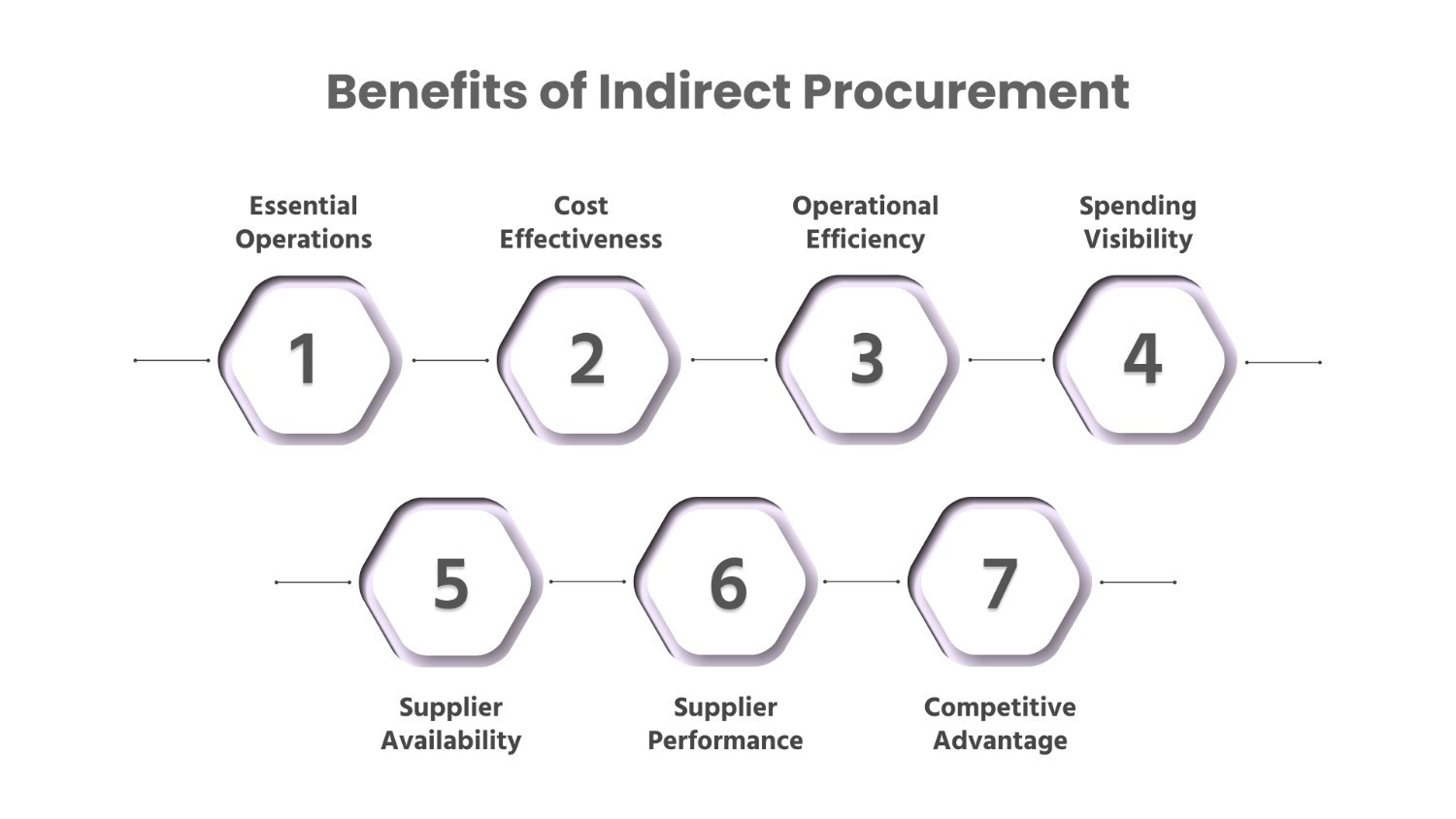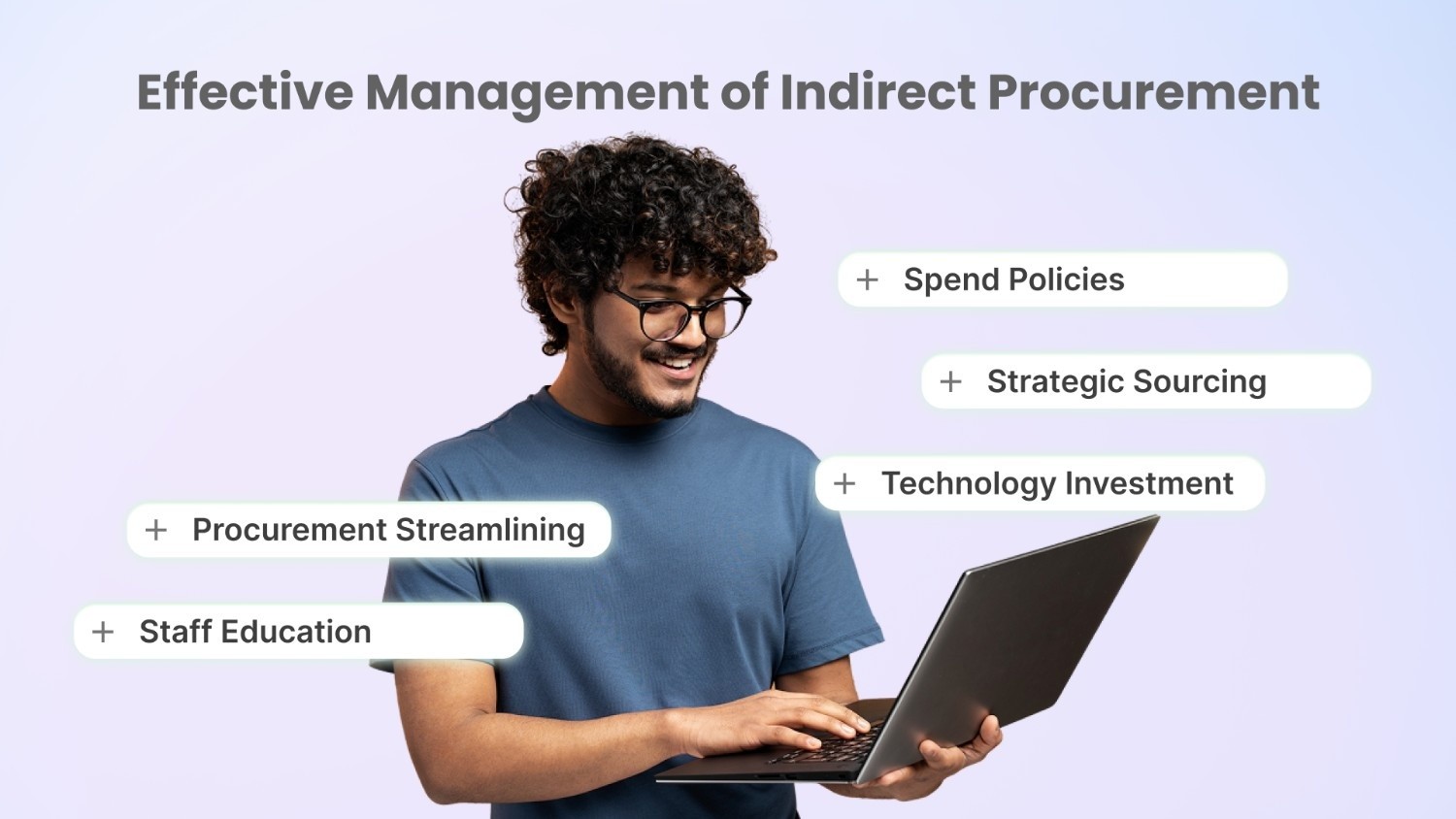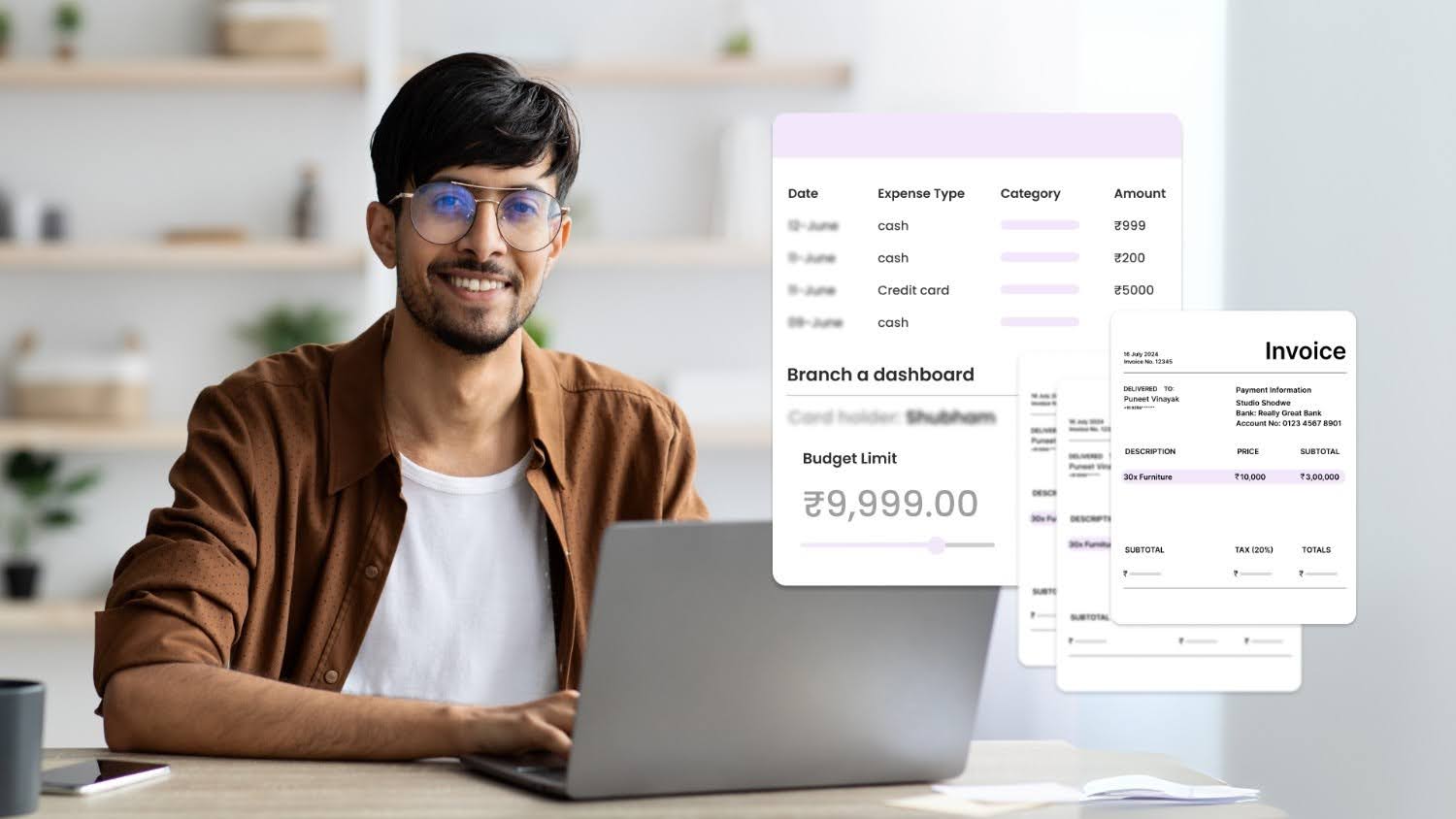Choose Smarter Spend Management Today!
Think of the last time your business made a major purchase. Was it the raw materials for production or the software that keeps your team connected?
Most businesses will be quick to focus on direct procurement. But what about those expenses that don’t end up in the final product?
This is where indirect procurement comes into play. Often overlooked or undervalued, it represents the lifeblood of smooth daily operations in any business. Think of it as the underlying processes that ensure everything functions without a hitch.
When appropriately managed, indirect procurement can drive cost efficiency, streamline operations, and improve your bottom line. However, when mishandled, it can lead to inefficiencies, unnecessary spending, and missed opportunities.
In this comprehensive article, we will dive deep into the concept of indirect procurement, explore its impact on day-to-day business operations, and discuss strategies to manage it effectively and leverage its benefits for greater operational efficiency.
What is Indirect Procurement?
Indirect procurement refers to the purchase of goods and services that support your company's day-to-day operations but are not directly incorporated into its final products or services. These purchases are essential for maintaining business continuity and operational efficiency. Essentially, anything that supports your business's internal operations without being part of the core product falls under indirect procurement.
Indirect procurement significantly impacts the smooth functioning of everyday operations. When managed effectively, it can reduce costs, enhance operational efficiency, and improve the quality of services and products offered. A good indirect procurement strategy ensures all resources are used efficiently, expenses are controlled, and your business continues to operate without disruptions.
Armed with this foundational knowledge, it’s only fair that we explore the primary categories and examples of indirect procurement, too.
Categories and Examples of Indirect Procurement
Indirect procurement comprises a broad spectrum of goods and services essential for your company's daily operations but not directly tied to its core product. Understanding these categories helps your business manage costs, optimise processes, and ensure smooth functioning across departments.
Here are the most common indirect procurement categories you absolutely must know about:
Rent for Facility: Your office space rental is a significant indirect expense, often constituting a large portion of fixed costs. It includes leasing offices, warehouses, and other facilities necessary for operations but not directly involved in production. Managing these costs effectively can lead to substantial savings.
Office Supplies and Equipment: Everyday items like stationery, computers, printers, and ergonomic furniture fall under this category. While individually low-cost, collectively they represent a significant expenditure. Streamlining procurement and usage can enhance your business’s productivity and reduce waste.
Professional and Human Services: Vital services such as legal counsel, HR consulting, and training programs are also considered an indirect procurement category. These services support various functions, from compliance to employee development, ensuring your company operates efficiently and stays competitive.
Marketing, Advertising, and Travel Expenses: Another category of indirect procurement involves promotional activities, digital campaigns, and business travel that are essential for brand visibility and client engagement. While not linked to product manufacturing, these expenses drive your revenue and market presence.
Information Technology, SaaS, and Telecommunications Expenses: Cloud services, SaaS subscriptions, internet services, and other communication tools are another type of indirect procurement that are crucial for your business. They facilitate collaboration, data management, and secure operations, supporting both remote and in-office work environments.
Utilities, Maintenance, and Repair Costs: Regular expenses like electricity, water, HVAC maintenance, and equipment repairs that ensure uninterrupted operations also come under indirect procurement. Neglecting these can lead to downtime and increased emergency costs.
Miscellaneous Expenses: This indirect procurement category covers a diverse range of expenditures, including employee uniforms, vehicle fleet management, and corporate gifts. Though varied, they contribute immensely to your employee satisfaction and operational efficiency.
Having discussed the different categories of indirect procurement, it’s natural to want to understand how it will be beneficial for your business.
Importance and Benefits of Indirect Procurement

Indirect procurement plays a crucial yet often underappreciated role in your business’s overall functioning. Its significance lies in its direct impact on the efficiency and cost-effectiveness of all business operations. Although not immediately visible to customers, the smooth operation of various indirect processes is what ensures your business runs efficiently.
Let’s quickly understand what benefits you can unlock by strategically managing your indirect procurement.
Essential for Daily Operations
Indirect procurement ensures the availability of essential resources like office supplies, utilities, and IT services, enabling smooth daily operations. Without these, your business would face disruptions, impacting productivity and employee morale.
Greater Cost Effectiveness
Your business can unlock significant cost savings by consolidating purchases for different departments and negotiating better terms with suppliers. Strategic sourcing and making purchases in bulk help in reducing unit costs and unlocking volume discounts.
More Operational Efficiency
Streamlining indirect procurement processes through automation and standardised procedures reduces manual errors and processing time. This leads to enhanced productivity across departments, allowing your staff to focus on core business activities.
Better Visibility into Business Spending
By implementing spend analytics tools, dashboards, and AI integration, you can unlock actionable insights into your spending patterns and identify areas of overspending or inefficiencies. This transparency enables informed decision-making, budget adjustments, and strategic planning.
Improvement in Supplier Availability
Optimising indirect procurement enables your business to explore more potential suppliers, compare prices, and negotiate competitive deals. In the event of a supply chain disruption, having a broader, reliable supplier base reduces the risk of stockouts and operational delays.
Chance to Assess Supplier Performance
Regular evaluation of supplier performance through key performance indicators (KPIs) can help identify top-performing suppliers, which your business can nurture further for better growth. This continuous assessment drives accountability and encourages your suppliers to maintain high service levels.
Boost in Competitive Advantage
Efficient indirect procurement practices lead to access to innovative products, cost savings, improved supplier relationships, and enhanced operational capabilities. This enables your business to allocate resources more effectively and respond swiftly to new market opportunities.
Ready to optimise your indirect procurement processes? Get started with Kodo today and transform the way your business manages spend.
Next, let’s see how indirect procurement is different from direct procurement, but why both are important for your organisational success.
Differences Between Direct and Indirect Procurement
When it comes to procurement, businesses engage in two distinct types: direct and indirect. While both categories are crucial to your success, they serve different purposes within your organisation.
Let’s explore how direct and indirect procurement differ in terms of strategy, operations, and management.
Aspect | Direct Procurement | Indirect Procurement |
Definition | Acquiring goods and services directly involved in the production of a company's products or services. | Purchasing goods and services that support day-to-day operations but are not part of the final product. |
Examples | Raw materials, components, packaging, and production equipment. | Rent, office supplies, IT services, utilities, maintenance, and marketing services. |
Nature and Focus | Operational and strategic, focuses on ensuring the availability of materials for production. | Operational; focuses on maintaining the infrastructure and services necessary for business operations. |
Purchase Volume | Typically, large quantities are purchased at a lower price, infrequent intervals. | Smaller quantities are purchased more frequently. |
Strategic Importance | Highly important since they directly impact production and revenue generation. | Moderately important since they support operations but don't directly affect product output. |
Budgeting and Planning | Centralised and detailed planning often involves long-term contracts and forecasts. | Decentralised planning; budgets may vary across departments and are more flexible. |
Management’s Focus | Ensuring supply chain continuity, cost control, and quality assurance. | Managing operational costs, supplier relationships, and service quality. |
Supplier Relationships | Long-term partnerships with key suppliers to ensure consistent quality and supply. | Short-term or transactional relationships may involve multiple suppliers for different needs. |
Organisational Setup | Often managed by a dedicated procurement team with close ties to production and R&D departments. | Managed across various departments; less centralised, with individual teams handling their specific needs. |
Understanding these key differences is your first step towards optimising procurement strategies in your company.
With a clearer understanding of these differences, it’s important to also recognise the unique challenges that come with managing indirect procurement.
Challenges in Indirect Procurement
Indirect procurement, while essential to business operations, is fraught with challenges. Without proper management, it can lead to inefficiencies, uncontrolled spending, and strained supplier relationships. Understanding these challenges is crucial for streamlining procurement and achieving better control over your business expenses.
Let’s take a deeper look at the common issues your business might face with indirect procurement.
Lack of Centralised Procurement Policies: Without centralised policies, departments can make purchases without any oversight, leading to inconsistent spending patterns and misalignment with your company's goals. This results in inefficient purchasing processes and fragmented supplier relationships, making it harder to track expenses effectively.
Poor Spend Visibility: Your business can struggle with poor visibility into your indirect procurement spending, hindering your ability to make informed decisions. Without clear data, it's challenging to identify potential savings, track performance, or optimise vendor relationships, ultimately affecting your financial health and operational efficiency.
Risks of Maverick Spend: Your employees can bypass formal procurement processes and make unauthorised purchases, leading to inflated costs. This often results from a lack of training and poorly enforced procurement policies, creating further difficulties in maintaining control over your business spending.
Inadequate Analytics: Without proper analytics tools, your business can fail to decode its spending patterns, making it difficult to negotiate better deals, reduce costs, and address other inefficiencies in your procurement processes.
Issues with Supplier Relationship Management: In the absence of a dedicated indirect procurement team, suppliers lack oversight on their performance. You’ll also encounter issues with effectively monitoring and engaging with different suppliers, making it difficult to build meaningful supplier relationships.
However, there are some proven strategies that can help you effectively address these challenges.
Strategies for Effective Management of Indirect Procurement

Effective management of indirect procurement is essential for businesses that want to maximise efficiency, reduce costs, and improve overall performance. By implementing strategies, your company can gain better control over its spending , ensure the timely availability of necessary resources, and foster stronger relationships with suppliers.
Let’s explore key strategies to manage indirect procurement and achieve operational excellence effectively.
Establish Comprehensive Spend Policies
Establish a centralised system that tracks indirect spending across all departments with the same scrutiny as direct procurement. By setting guidelines for approval workflows and purchase requests, your business can identify inefficiencies and potential cost-saving areas and maintain budgetary control. This also promotes transparency and accountability in procurement activities.
Practice Strategic Sourcing
Periodically evaluate your suppliers based on different criteria like cost, quality, and reliability. Wherever possible, renegotiate contracts to ensure you’re receiving the best price for products. Build long-term relationships with selected suppliers to unlock better quality products, innovation, and sustainability, and mitigate risks. This ensures consistent value beyond mere cost savings.
Invest in the Right Technology Solutions
Utilise cutting-edge technology such as procurement software to automate routine tasks to reduce manual errors, improve spend visibility, and make informed decisions. Choose a solution that offers a digital procure-to-pay process with automated workflows, controls, notifications, and centralized records.
Tools like Kodo's Purchase Request and Invoice Management can streamline workflows and provide real-time insights to improve your business’s overall efficiency.
Streamline the Procurement Processes
Set up a simplified indirect procurement workflow that optimises the labour-intensive processes like supplier onboarding and spend monitoring. This can lead to faster processing times and reduced administrative burden. You can also standardise procurement procedures across departments to enhance operational efficiency and reduce delays.
Educate Staff on Indirect Procurement
Lastly, train your employees on procurement policies and best practices to foster a culture of responsible spending. Promote inter-departmental communication to ensure everyone is aligned with your policies. By equipping staff with the knowledge to make informed purchasing decisions, you can minimise maverick spending and ensure compliance with established guidelines.
Adopting these strategies allows your business to effectively manage indirect procurement, leading to cost savings and improved operational efficiency.
How Can Kodo Simplify Your Indirect Procurement?
As India’s leading all-in-one spend management and procurement platform, Kodo can easily simplify indirect procurement for businesses of all sizes. Our comprehensive suite of features ensures your business can manage its procurement needs with ease, reducing manual errors and increasing operational efficiency.
Here’s how Kodo can help your business:
Automating Procurement Workflows: With Kodo, you can automatically track and approve purchase requests, create and manage purchase orders, and automatically generate invoices for approvals. This ensures your team spends less time on administrative tasks and more time focusing on what matters most.
Real-Time Visibility into Spending: Our intuitive dashboard provides real-time insights into your company’s expenses, allowing you to monitor all procurement activities in one place, track spending against budgets, and identify areas for potential savings.
Streamlining the Procure-to-Pay Process: We offer a fully integrated procure-to-pay (P2P) solution that simplifies the entire procurement cycle. This helps your business save time, reduce errors, and maintain a clear audit trail, improving overall procurement efficiency.
Improved Supplier Relationship Management: You can manage supplier relationships more effectively by paying them promptly, tracking supplier performance, maintaining transparent communication, and identifying opportunities for negotiating better terms.
Scalable Solutions for Growing Businesses: Kodo is designed to scale with your company, providing the flexibility to adapt to changing requirements. Our platform ensures your indirect procurement processes remain efficient and cost-effective at every stage of growth.
Kodo’s seamless solution ensures that your indirect procurement processes are aligned with your business goals.
Final Thoughts

Indirect procurement is often viewed as the ‘behind-the-scenes’ engine that keeps your business running smoothly. In fact, optimizing indirect procurement processes directly influences your bottom line and the efficiency of your operations.
However, managing this complex web of non-core purchases can be time-consuming and prone to inefficiencies without the right strategy or tools in place. This is where Kodo steps in.
By offering an integrated platform that simplifies and automates the entire indirect procurement process, we empower your business to streamline its procurement workflows, gain better control, and achieve greater transparency.
Ready to transform your indirect procurement strategy? Book a call with our experts and experience a simpler, smarter way to manage your business spend.

